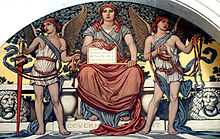Public expenditure
| Public finance |
|---|
 |
|
|
|
Reform |
Public expenditure is spending made by the government of a country on collective needs and wants such as pension, provision, infrastructure, etc.[1] Until the 19th century, public expenditure was limited as laissez faire philosophies believed that money left in private hands could bring better returns. In the 20th century, John Maynard Keynes argued the role of public expenditure in determining levels of income and distribution in the economy. Since then government expenditures has shown an increasing trend.
In the 17th and the 18th century Public Expenditure was considered as a wastage of money.Thinkers said Government should stay with their traditional functions of spending on defence and maintaining law and order.
Theories of public expenditure
Several theories of taxation exist in public economics. Governments at all levels (national, regional and local) need to raise revenue from a variety of sources to finance public-sector expenditures. The details of taxation are guided by two principles: who will benefit, and who can pay.
Principle of Maximum Social Advantage
Taxation (government revenue) and government expenditure are the two tools. Neither of excess is good for the society, it has to be balanced to achieve maximum social benefit. Dalton called this principle as “Maximum Social Advantage” and Pigou termed it as “Maximum Aggregate Welfare”.
Dalton’s Principle of Maximum Social Advantage- Maximum satisfaction should be yield by striking a balance between public revenue and expenditure by the government. Economic welfare is achieved when marginal utility of expenditure = marginal disutility of taxation. He explains this principle with reference to
- Maximum Social Benefit (MSB)
- Maximum Social Sacrifice (MSS)[3]
In the given figure “P” is the point of Maximum Social Advantage. At this point MSS=MSB.
At a point before P, i.e. “P1” P1S1 > Q1S1 which implies MSB>MSS. And at point after P, i.e. “P2” MSS>MSB as Q2P2>S2P2.

Voluntary Exchange Theory of Lindhal
It was introduced by Swedish Economist “Erik Lindahl in 1919”.[4] According to his theory, determination of public expenditure and taxation will happen on the basis of public preferences which they will reveal themselves. Cost of supplying a good will be taken up by the people. The tax that they will pay will be revealed by them according to their capacities.[5]
Causes of growth of public expenditure
There are several factors that have led to enormous increase in public expenditure through the years
'Defense Expenditure due to modernization of defense equipment by navy, army and air force to prepare the country for war or for prevention causes-for-growth-of-public-expenditure.
Population growth: It increases with the increase in population, more of investment is required to be done by government on law and order, education, infrastructure, etc. investment in different fields depending on the different age group is required.
Welfare activities- welfare, mid-day meals, pension provisions etc.
- Provision of public and utility services-provision of basic public goods given by government (their maintenance and installation) such as transportation.
- Accelerating economic growth- in order to raise the standard of living of the people.
- Price rise- higher price level compels government to spend increased amount on purchase of goods and services.[6]
- Increase in public revenue- with rise in public revenue government is bound to increase the public expenditure.
- International Obligation- maintenance of socio economic obligation, cultural exchange etc. (these are indirect expenses of government)
References
- ↑ Akrani, Gaurav. "Meaning of Public Expenditure". Retrieved 15 February 2012.
- ↑ "Diminishing Marginal Social Benefit Curve". Retrieved 20 February 2012.
- ↑ "Dalton's Principle of Maximum Social Advantage". Retrieved 20 February 2012.
- ↑ "Lindhal Equilibrium". Retrieved 20 February 2012.
- ↑ Singh, S.K. Voluntary Exchange Theory of Lindhal for Determination of Public expenditure. S.Chand and Company Ltd. pp. 57–59. ISBN 81-219-1091-9.
- ↑ "Causes for Growth of public expenditure". Retrieved 20 February 2012.